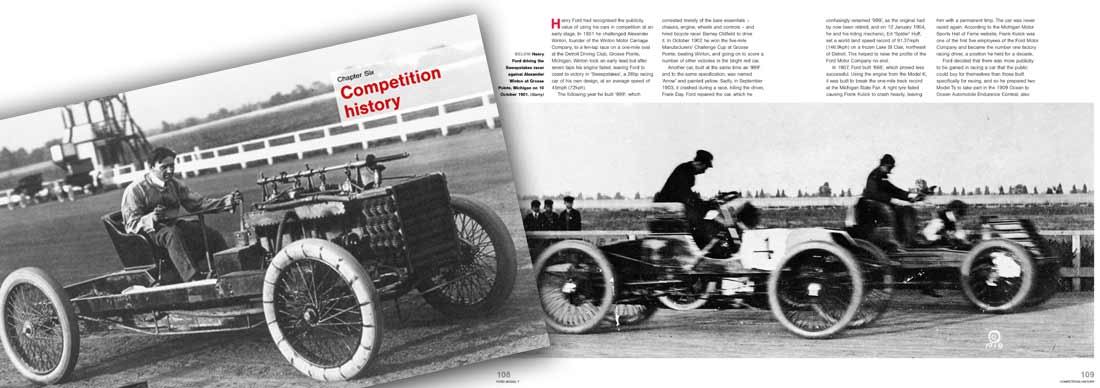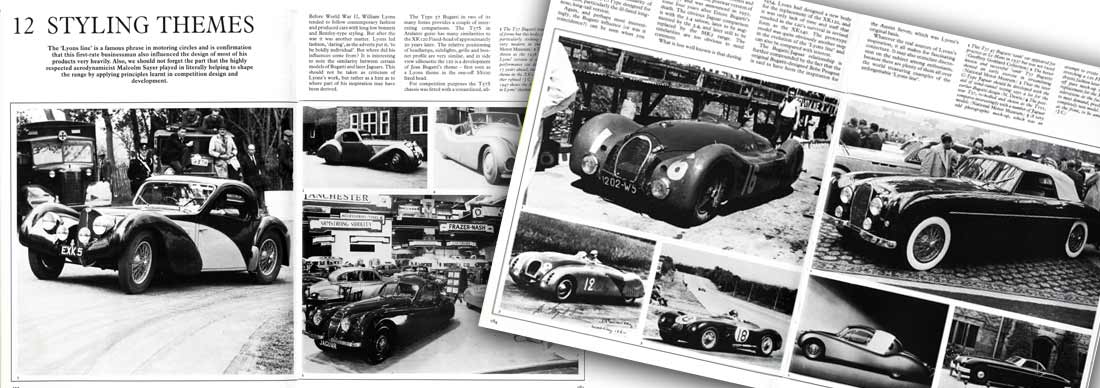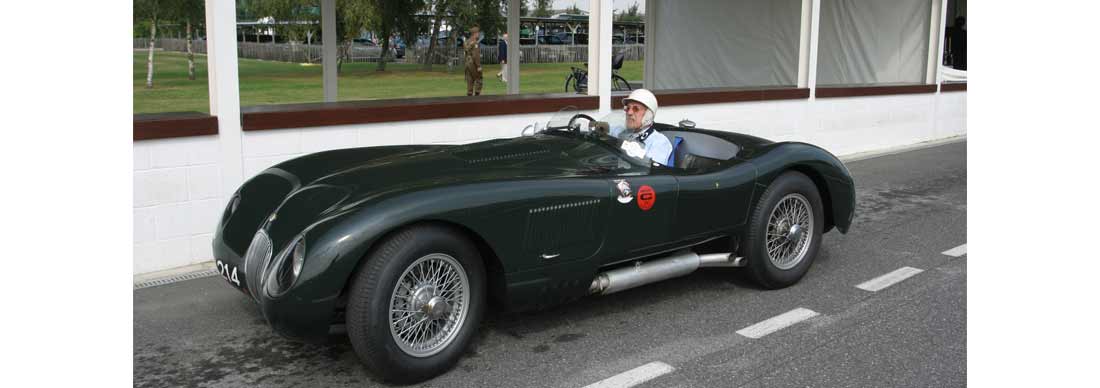
Competition History

Above: After building the massive ‘999’ race car in 1902, Henry Ford was reluctant to drive it himself. Instead, he hired bicycle racer Barney Oldfield, who went on to score a number of victories in the car. (Alamy)

Above: Henry Ford driving the Sweepstakes racer against Alexander Winton at Grosse Pointe, Michigan on 10 October 1901. (Alamy)
Henry Ford had recognised the publicity value of using his cars in competition at an early stage. In 1901 he challenged Alexander Winton, founder of the Winton Motor Carriage Company, to a ten-lap race on a one-mile oval at the Detroit Driving Club, Grosse Pointe, Michigan. Winton took an early lead but after seven laps his engine failed, leaving Ford to coast to victory in ‘Sweepstakes’, a 26hp racing car of his own design, at an average speed of 45mph (72kph).
The following year he built ‘999’, which consisted merely of the bare essentials –
chassis, engine, wheels and controls – and hired bicycle racer Barney Oldfield to drive it. In October 1902 he won the five-mile Manufacturers’ Challenge Cup at Grosse Pointe, beating Winton, and going on to score a number of other victories in the bright red car.
Another car, built at the same time as ‘999’ and to the same specification, was named ‘Arrow’ and painted yellow. Sadly, in September 1903, it crashed during a race, killing the driver, Frank Day. Ford repaired the car, which he confusingly renamed ‘999’, as the original had by now been retired, and on 12 January 1904, he and his riding mechanic, Ed ‘Spider’ Huff, set a world land speed record of 91.37mph (146.9kph) on a frozen Lake St Clair, northeast of Detroit. This helped to raise the profile of the Ford Motor Company no end.
In 1907, Ford built ‘666’, which proved less successful. Using the engine from the Model K, it was built to break the one-mile track record at the Michigan State Fair. A right tyre failed causing Frank Kulick to crash heavily, leaving him with a permanent limp. The car was never raced again. According to the Michigan Motor Sports Hall of Fame website, Frank Kulick was one of the first five employees of the Ford Motor Company and became the number one factory racing driver, a position he held for a decade. Ford decided that there was more publicity to be gained in racing a car that the public could buy for themselves than those built specifically for racing, and so he prepared two Model Ts to take part in the 1909 Ocean to Ocean Automobile Endurance Contest, also known as the Transcontinental Contest for the Guggenheim Trophy. This was run from New York to Seattle, with the first car leaving New York on 1 June 1909 and arriving on 23 June. It was held in conjunction with the Yukon-Pacific Exposition, the world’s fair at Seattle, which also began on 1 June.

Above: (top left) Ford entered two Model Ts in the Ocean to Ocean race in 1909. Frank Kulick and H.P. Harper drove one car, with Bert Scott and Jimmy Smith in the other. The cars are shown near the starting line in New York. (Ford Images)
(bottom left) Bert Scott and Jimmy Smith shared the No. 2 Model T entry in the 1909 Ocean to Ocean race. (Ford Images)
(top right) One of the cars bogged down in the mud in Utah. (Alamy)
Both Model Ts were four-cylinder 20hp, 1,200lb (544kg) models, and Ford was allocated the numbers one and two as it was the first manufacturer to enter. Car No. 1 was driven by Frank Kulick and H.P. Harper and No. 2 by Bert Scott and Jimmy Smith. Recounting the event in The Story of the Race, published by the Ford Motor Company, one of the drivers of Ford No. 1, though not identified, wrote: ‘Every day we wore rubber coats and hip boots and pushed through mile after mile of mud. The monotony of this was frequently varied by having to ford a stream where the unusual rainfall had washed away the bridge. Often these swollen streams had beds of quicksand and the car striking them would instantly sink until the body resting on the sand prevented further settling. Then we thanked our lucky stars that we of the Ford crews were driving light cars. Where a heavy car had to resort to horses and a block and tackle, the two men in each Ford car could pick up their car, place the wheels on planks and proceed along.’
The race was won by the No. 2 Ford, driven by Scott and Smith, which covered the 4,106 miles in 20 days and 52 minutes, 17 hours ahead of the second-placed car, a Shawmut. The No. 1 Ford lost time and finished third. Only much later was it discovered that the winning Ford had had its engine replaced part way through the event, thereby disqualifying it. By then, Ford had enjoyed the publicity surrounding the event anyway. The race was re-enacted in 2009 with 35 Model T Fords taking part.
Between 1910 and 1913, Frank Kulick raced a highly modified Model T, entered by the Ford Motor Company, at a number of events.
On 17 February 1912, he reached 107.8mph (173.5kph) on the frozen Lake St Clair, near Detroit. Ford ended official participation in competition in 1913, as by then it was too busy making and selling the cars and deemed the extra publicity unnecessary.

Above: Frank Kulick driving his Ford at the 1910 Point Breeze racetrack in
Philadelphia. (Detroit Public Library)
However, Ford didn’t need to go racing himself, as many Model T owners were already doing it for him, using their machines as the basis for a number of heavily modified stock cars, which they raced on small, dirt, oval tracks. Many of these featured a special cylinder head made by the Frontenac company, which had been formed by the Chevrolet brothers, Louis and Arthur, in 1916. It was named after Comte de Frontenac, the 17th-century governor of France’s North American colonies, in order to disguise the fact that the Chevrolets were making components for other manufacturers’ cars. The company made cylinder heads and valve assemblies for Model T dirt track racers, which tripled the available power. They proved highly successful and were still in use in the 1940s.
The Frontenac Ford, or ‘Fronty’ as it was known, was an overhead valve conversion for the 2.9-litre (177-cu in) Ford engine, although a special version was made for the 2.0-litre (122-cu in) engine in order to conform with the rules for the Indianapolis 500. Around 10,000 Frontenac cylinder heads of various types were made and the original featured a single inlet port with triple exhaust ports in a crossflow design. The ‘R’ was for race cars, the ‘S’ for road-going Speedsters, and the ‘T’ version for touring cars and trucks. The later ‘S-R’ included two intake ports and provision for spark plugs on either side of the head. In 1924 the company developed the ‘D-O’ (or double overhead) which featured 16 valves, two inlet and exhaust per cylinder, and two chaindriven camshafts. The crossflow design had separate inlet and exhaust ports for each cylinder, with spark plugs located in the top of the head.
By Chas Parker






Leave a comment
This site is protected by hCaptcha and the hCaptcha Privacy Policy and Terms of Service apply.